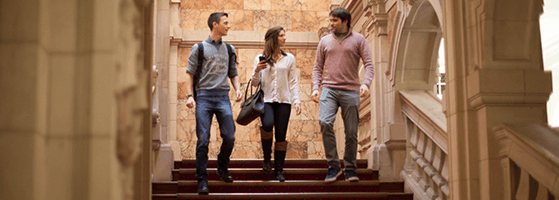1 July 2021
Supporting students' transition to university during COVID-19

Authors
Dr Pam Birtill
Associate Professor of Psychology
Dr Richard Harris
Deputy Director of Student Education, Lecturer in Psychology
Madeleine Pownall
PhD researcher and Postgraduate Teaching Assistant
Dr Pam Birtill, Dr Richard Harris and Madeleine Pownall from the University of Leeds share five recommendations to help providers and university staff facilitate successful student transitions into university in 2021.
This blog was produced as part of QAA Membership’s work supporting successful student transitions. A collection of new and curated resources focused on supporting transitions into, through and out of higher education is now available for QAA Members on our Membership Resources site.
Post-16 is when young people develop independence and gain freedom, as they transition from compulsory schooling to more diverse educational environments. However, many of the formative experiences of early adulthood have been curtailed by social distancing and closure of non-essential services during the global pandemic. And, of relevance to us as educators, the typical transition to university process has also been impacted for example by university closures which have meant that students have not been able to explore the campus or experience in person ‘taster’ days. As a result, this year students may experience notable challenges in adjusting to university.
We wanted to explore this further, by developing guidelines that would help us and other educators to support students as they begin their university journey in the context of COVID-19 disruptions to learning and transition. We wrote a preprint and framed our recommendations within Lizzio’s ‘Five senses of student success’ model, which suggests that success in university can be categorised as relating to student capability, connectedness, purpose, resourcefulness and culture. In this blog, we will discuss these in turn, noting our recommendations for facilitating the transition of students in the context of COVID-19.
Capability
Capability refers to students’ ability to master academic knowledge and skills, grasp subject-specific content, and understand their role as learners. Experiences of pre-tertiary teaching forms the basis for expectations about university, which provides students with a sense of capability. For the 2021-22 cohort of students, we need to ensure students grasp academic content, given the need to ‘reacclimatise’ to academic studying. Students may not be as ‘learning ready’ as in previous years, and we should be mindful of this when developing teaching content, setting learning outcomes, and in our assessment practice. We recommend that expectations throughout the curriculum are clearly communicated, with an increased emphasis on supported formative assessments, working in partnership with students, and championing flexibility.
Connectedness
A strong sense of belonging or connectedness at university is associated with students’ feeling that they have ‘earned’ or ‘deserved’ their place. If students do not feel that their place at university is legitimately earned, for example because of the change in assessments, they may experience imposter syndrome, or feel like a fraud.
There may be an increase in students experiencing imposter syndrome as a result of reduced access to the physical and social environment of university campuses. Given that some online teaching is likely to persist into the next academic year, students may not experience frequent in-person peer-to-peer social interaction. This lack of social interaction and a strong social network is likely to affect student’s sense of belonging. Therefore, efforts to establish authentic social support will also be important. We should account for this in our student support practice, by responding sensitively and proactively to support students’ sense of belonging during this year with peer-to-peer support and collaborative group working.
Purpose
Students’ sense of purpose enables them to access help and support more readily, for both academic and pastoral matters, including student mental health. Student mental health has been on the higher education agenda for several years, and COVID-19 has increased the prevalence of mental health symptoms among university students, which are likely to persist. Therefore, we should embed consideration of mental health needs into the university curriculum as part of an inclusive curriculum design process.
We also need to reappraise ‘reasonable adjustments’ in student education, accounting for the long-lasting mental health effects of COVID-19 on new students when setting and managing educational expectations. We should consider how course and module structures can be adjusted to minimise the need for reasonable adjustments and encourage accessibility for all students.
Resourcefulness
For students to be able to develop their sense of resourcefulness, they need access to the ‘unspoken rules’ or ‘hidden curriculum’ of academia. In the context of transitions to university, ‘hidden curriculum’ refers to the practices, processes and values that students are assumed to understand but that are not explicitly taught.
Students use both ‘hot’ and ‘cold’ knowledge to understand the university context. Hot knowledge is information acquired ‘through the grapevine’, such as from speaking to peers, second-hand recommendations, and social networks. In contrast, ‘cold’ knowledge is obtained through ‘official routes’ such as open days, prospectuses, and websites. Access to hot knowledge has clearly been impacted by COVID-19; students have had little opportunity to speak to other students at applicant events or open days. We should therefore consider how the ‘unspoken rules’ or ‘hidden curriculum’ of university can be shared with new students. We should avoid assuming that students have prior knowledge about university life.
Culture
Finally, students need to access, understand, and readily participate in the culture of higher education, to develop an appreciation for the university’s values, ethics and norms, and to create a new ‘student’ identity. Given that pre-university experiences often determine whether students can understand and participate in the ‘culture’ of university, students who have not had access to adequate pre-university support may struggle more to develop their identity as a higher education student. Therefore, COVID-19 may widen the gap between students who are ‘trained’ for university and those who are not, exacerbating existing inequalities. Indeed, a concern for (in)equality runs through all the considerations we have raised. Students’ capability may be affected by the quality and quantity of their pre-tertiary education provision, which is affected by students’ socioeconomic background.
Similarly, there are also likely to be inequalities in new students’ sense of belonging or connectedness to university. Students with disabilities may also be unfairly disadvantaged by online teaching and the impact of COVID-19. As ever, we should be mindful of these systemic inequalities and be prepared to champion equality and inclusion in the university transition. We should embed equality, diversity, and inclusion into all aspects of the student experience.
Conclusion
These five recommendations to support students in the 2021-22 academic year require institutional and managerial support to implement meaningfully, and we recognise that schoolteachers, parents and higher education teaching staff are all under an immense amount of pressure during COVID-19 times. These recommendations are not a prescriptive set of ‘rules’, but a series of evidence-based recommendations that can be adapted. We also recognise that COVID-19 will have affected different students in diverse ways. However, these recommendations can be applied to support all students in their transition.


